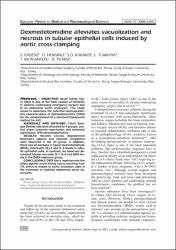Dexmedetomidine alleviates vacuolization and necrosis in tubular epithelial cells induced by aortic cross-clamping

Göster/
Erişim
info:eu-repo/semantics/openAccessTarih
2023Yazar
Ergene, ŞabanHemşinli, Doğuş
Karakişi, Sedat Ozan
Tümkaya, Levent
Mercantepe, Tolga
Yılmaz, Adnan
Üst veri
Tüm öğe kaydını gösterKünye
Ergene, S., Hemsinli, D., Karakisi, S. O., Tumkaya, L., Mercantepe, T., & Yılmaz, A. (2023). Dexmedetomidine alleviates vacuolization and necrosis in tubular epithelial cells induced by aortic cross-clamping. European review for medical and pharmacological sciences, 27(8), 3396–3405. https://doi.org/10.26355/eurrev_202304_32110Özet
OBJECTIVE: Acute kidney inju-ry (AKI) is one of the main causes of mortality in patients undergoing emergency surgery due to an abdominal aortic aneurysm. This study aimed to determine the potential nephroprotec-tive characteristics of dexmedetomidine (DMD) for the establishment of a standard therapeutic method for AKI.MATERIALS AND METHODS: Thirty Spra-que Dawley rats were allocated to 4 groups: con-trol, sham, ischemia-reperfusion, and ischemia/ reperfusion (I/R)+dexmedatomidine.RESULTS: Necrotic tubules, degenerative Bowman's capsule and vascular congestion were observed in the I/R group. In addition, there was an increase in tissue malondialdehyde (MDA), interleukin (IL)-1 and IL-6 levels in tubu-lar epithelial cells. In contrast, we observed de-creased tubular necrosis, IL-1, IL-6 and MDA lev-els in the DMD treatment group.CONCLUSIONS: DMD has a nephroprotective effect against acute kidney injury resulting from I/R, which is related to aortic occlusion used in the treatment of ruptured abdominal aortic an-eurysms.

















